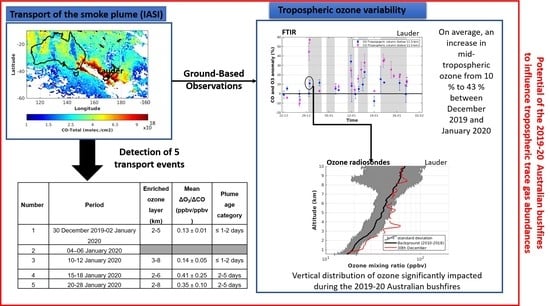Transport and Variability of Tropospheric Ozone over Oceania and Southern Pacific during the 2019–20 Australian Bushfires
Abstract
:1. Introduction
2. Instruments and Data Sets
2.1. Ozone and CO Measurements
2.1.1. FTIR
2.1.2. Ozone Radiosondes
2.1.3. Satellite Date
MLS
IASI
2.2. Aerosols Data Sets
2.2.1. Sun-Photometer CIMEL
2.2.2. Satellite Data
CALIOP
GOME-2
2.3. MODIS Fire Data
3. Australian Biomass Burning Event
3.1. CO and Aerosols Total Columns over Australia
3.2. Tropospheric Smoke Plume
4. Discussion on the Tropospheric Ozone Variability
4.1. Spatial Extend of the Tropospheric Ozone Plume
4.2. Statistical Variation of the Tropospheric Ozone
5. Conclusions
Author Contributions
Funding
Institutional Review Board Statement
Informed Consent Statement
Data Availability Statement
Acknowledgments
Conflicts of Interest
References
- Krupa, S.V.; Manning, W.J. Atmospheric ozone: Formation and effects on vegetation. Environ. Pollut. 1988, 50, 101–137. [Google Scholar] [CrossRef]
- Andreae, M.O.; Merlet, P. Emission of trace gases and aerosols from biomass burning. Glob. Biogeochem. Cycles 2001, 15, 955–966. [Google Scholar] [CrossRef] [Green Version]
- Crutzen, J.P.; Carmichael, G.R. Modeling the influence of fires on atmospheric chemistry. In Fire in the Environment: The Ecological, Atmospheric, and Climatic Importance of Vegetation Fires; Crutzen, P.J., Goldhammer, J.G., Eds.; John Wiley: New York, NY, USA, 1993; pp. 89–106. [Google Scholar]
- Duflot, V.; Dils, B.; Baray, J.L.; de Maziere, M.; Attié, J.-L.; Vanhaelewyn, G.; Senten, C.; Vigouroux, C.; Clain, G.; Robert, D. Analysis of the origin of the distribution of CO in the subtropical southern Indian Ocean in 2007. J. Geophys. Res. 2010, 115, D22106. [Google Scholar] [CrossRef] [Green Version]
- Wang, W.; Pinto, J.P.; Yung, Y.L. Climatic effects due to halogenated compounds in the Earth’s atmosphere. J. Atmos. Sci. 1980, 37, 333–338. [Google Scholar] [CrossRef]
- Garstang, M.; Tyson, P.D.; Swap, R.; Edwards, M.; Kållberg, P.; Lindesay, J.A. Horizontal and vertical transport of air over southernAfrica. J. Geophys. Res. 1996, 101, 23721–23736. [Google Scholar] [CrossRef]
- Holanda, B.A.; Pöhlker, M.L.; Walter, D.; Saturno, J.; Sörgel, M.; Ditas, J.; Pöhlker, C. Influx of African biomass burning aerosol during the Amazonian dry season through layered transatlantic transport of black carbon-rich smoke. Atmos. Chem. Phys. 2020, 20, 4757–4785. [Google Scholar] [CrossRef] [Green Version]
- Torres, O.; Chen, Z.; Jethva, H.; Ahn, C.; Freitas, S.R.; Bhartia, P.K. OMI and MODIS observations of the anomalous 2008–2009 Southern Hemisphere biomass burning seasons. Atmos. Chem. Phys. 2010, 10, 3505–3513. [Google Scholar] [CrossRef] [Green Version]
- Morgenstern, O.; Zeng, G.; Wood, S.W.; Robinson, J.; Smale, D.; Clare, M.; Jones, N.B.; Griffith, D.W.T. Long-range correlations in Fourier transform infrared, satellite, and modeled CO in the Southern Hemisphere. J. Geophys. Res. 2012, 117, D11301. [Google Scholar] [CrossRef] [Green Version]
- Edwards, D.P.; Emmons, L.K.; Gille, J.C.; Chu, A.; Attié, J.L.; Giglio, L.; Drummond, J.R. Satellite-observed pollution from Southern Hemisphere biomass burning. J. Geophys. Res. 2006, 111, D14312. [Google Scholar] [CrossRef]
- Oltmans, S.J.; Johnson, B.J.; Harris, J.M.; Vömel, H.; Thompson, A.M.; Koshy, K.; Paredes, F. Ozone in the Pacific tropical troposphere from ozonesonde observations. J. Geophys. Res. Atmos. 2001, 106, 32503–32525. [Google Scholar] [CrossRef] [Green Version]
- Pak, B.; Langenfelds, R.; Young, S.; Francey, R.; Meyer, C.; Kivlighon, L.; Cooper, L.N.; Dunse, B.; Allison, C.; Steele, L.P.; et al. Measurements of biomass burning influences in the troposphere over southeast Australia during the SAFARI 2000 dry season campaign. J. Geophys. Res. 2003, 108, 8480. [Google Scholar] [CrossRef]
- Kaiser, J.W.; Keywood, M. Preface for Atmos. Env. Special issue on IBBI. Atmos. Environ. 2015, 121, 1–3. [Google Scholar] [CrossRef]
- Russell-Smith, J.; Yates, C.P.; Whitehead, P.J.; Smith, R.; Craig, R.; Allan, G.E.; Thackway, R.; Frakes, I.; Cridland, S.; Meyer, M.C.P.; et al. Bushfires’ down under’: Patterns and implications of contemporary Australian landscape burning. Int. J. Wildland Fire 2007, 16, 361–377. [Google Scholar] [CrossRef]
- Mallet, M.D.; Desservettaz, M.J.; Miljevic, B.; Milic, A.; Ristovski, Z.D.; Alroe, J.; Cravigan, L.T.; Jayaratne, E.R.; Paton Walsh, C.; Griffith, D.W.T.; et al. Biomass burning emissions in north Australia during the early dry season: An overview of the 2014 SAFIRED campaign. Atmos. Chem. Phys. 2017, 17, 13681–13697. [Google Scholar] [CrossRef] [Green Version]
- Shi, Y.; Matsunaga, T.; Saito, M.; Yamaguchi, Y.; Chen, X. Comparison of global inventories of CO2 emissions from biomass burning during 2002–2011 derived from multiple satellite products. Environ. Pollut. 2015, 206, 479–487. [Google Scholar] [CrossRef] [Green Version]
- van der Werf, G.R.; Randerson, J.T.; Giglio, L.; Collatz, G.J.; Kasibhatla, P.S.; Arellano, A.F., Jr. Interannual variability in global biomass burning emissions from 1997 to 2004. Atmos. Chem. Phys. 2006, 6, 3423–3441. [Google Scholar] [CrossRef] [Green Version]
- Andersen, A.N.; Cook, G.D.; Corbett, L.K.; Douglas, M.M.; Eager, R.W.; Russell-Smith, J.; Setterfield, S.A.; Williams, R.J.; Woinarski, J.C. Fire frequency and biodiversity conservation in Australian tropical savannas: Implications from the Kapalga fire experiment. Aust. Ecol. 2005, 30, 155–167. [Google Scholar] [CrossRef]
- Williams, R.J.; Gill, A.M.; Moore, P.H.R. Seasonal changes in fire behaviour in a tropical savanna in northern Australia. Int. J. Wild. Fire 1998, 8, 227–239. [Google Scholar] [CrossRef]
- Ristovski, Z.D.; Wardoyo, A.Y.; Morawska, L.; Jamriska, M.; Carr, S.; Johnson, G. Biomass burning influenced particle characteristics in Northern Territory Australia based on airborne measurements. Atmos. Res. 2010, 96, 103–109. [Google Scholar] [CrossRef] [Green Version]
- Cruz, M.G.; Sullivan, A.L.; Gould, J.S.; Sims, N.C.; Bannister, A.J.; Hollis, J.J.; Hurley, R.J. Anatomy of a catastrophic wildfire: The Black Saturday Kilmore East fire in Victoria Australia. For. Ecol. Manag. 2012, 284, 269–285. [Google Scholar] [CrossRef]
- Sullivan, A.L.; McCaw, W.L.; Cruz, M.G.; Matthews, S.; Ellis, P.F. Fuel, fire weather and fire behaviour in Australian ecosystems. In Flammable Australia; Bradstock, R.A., Gill, A.M., Williams, R.D., Eds.; CSIRO Publishing: Collingwood, Australia, 2012. [Google Scholar]
- Dowdy, A.J.; Pepler, A. Pyroconvection risk in Australia: Climatological changes in atmospheric stability and surface fire weather conditions. Geophys. Res. Lett. 2018, 45, 2005–2013. [Google Scholar] [CrossRef]
- Fromm, M.; Lindsey, D.T.; Servranckx, R.; Yue, G.; Trickl, T.; Sica, R. The untold story of pyro-cumulonimbus. Bul. Am. Meteorol. Soc. 2010, 91, 1193–1210. [Google Scholar] [CrossRef] [Green Version]
- Fromm, M.; Tupper, A.; Rosenfeld, D.; Servranckx, R.; McRae, R. Violent pyro-convective storm devastates Australia’s capital and pollutes the stratosphere. Geophys. Res. Lett. 2006, 33, L05815. [Google Scholar] [CrossRef]
- Mitchell, R.M.; O’Brien, D.M.; Campbell, S.K. Characteristics and radiative impact of the aerosol generated by the Canberra firestorm of January 2003. J. Geophys. Res. Atmos. 2006, 111, D02204. [Google Scholar] [CrossRef] [Green Version]
- McRae, R.H.D.; Sharples, J.J.; Wilkes, S.R.; Walker, A. An Australian pyro-tornadogenesis event. Nat. Haz. 2013, 65, 1801–1811. [Google Scholar] [CrossRef]
- Dirksen, R.J.; Boersma, K.F.; de Laat, J.; Stammes, P.; van der Werf, G.R.; Martin, M.V.; Kelder, H.M. An aerosol boomerang: Rapid around-the-world transport of smoke from the December 2006 Australian forest fires observed from space. J. Geophys. Res. 2009, 114, D21201. [Google Scholar] [CrossRef] [Green Version]
- Fromm, M.D.; McRae, R.H.D.; Sharples, J.J.; Kablick, G.P., III. Pyrocumulonimbus pair in Wollemi and Blue Mountains National Parks, 22 November 2006. Aust. Meteorol. Oceanogr. J. 2012, 62, 117–126. [Google Scholar] [CrossRef]
- Dowdy, A.J.; Fromm, M.D.; McCarthy, N. Pyrocumulonimbus lightning and fire ignition on Black Saturday in southeast Australia. J. Geophys. Res. Atmos. 2017, 122, 7342–7354. [Google Scholar] [CrossRef]
- De Laat, A.T.J.; Stein Zweers, D.C.; Boers, R.; Tuinder, O.N. A solar escalator: Observational evidence of the self-lifting of smoke and aerosols by absorption of solar radiation in the February 2009 Australian Black Saturday plume. J. Geophys. Res. Atmos. 2012, 117. [Google Scholar] [CrossRef] [Green Version]
- Pumphrey, H.C.; Santee, M.L.; Livesey, N.J.; Schwartz, M.J.; Read, W.G. Microwave Limb Sounder observations of biomass-burning products from the Australian bush fires of February 2009. Atmos. Chem. Phys. 2011, 11, 6285–6296. [Google Scholar] [CrossRef] [Green Version]
- Siddaway, J.M.; Petelina, S.V. Transport and evolution of the 2009 Australian Black Saturday bushfire smoke in the lower stratosphere observed by OSIRIS on Odin. J. Geophys. Res. 2011, 116, D06203. [Google Scholar] [CrossRef] [Green Version]
- Christian, K.; Yorks, J.; Das, S. Differences in the Evolution of Pyrocumulonimbus and Volcanic Stratospheric Plumes as Observed by CATS and CALIOP Space-Based Lidars. Atmosphere 2020, 11, 1035. [Google Scholar] [CrossRef]
- Kablick, G.P., III; Allen, D.R.; Fromm, M.D.; Nedoluha, G.E. Australian pyroCb smoke generates synoptic-scale stratospheric anticyclones. Geophys. Res. Lett. 2020, 47, e2020GL088101. [Google Scholar] [CrossRef]
- Khaykin, S.; Legras, B.; Bucci, S.; Sellitto, P.; Isaksen, L.; Tence, F.; Godin-Beekmann, S. The 2019/20 Australian wildfires generated a persistent smoke-charged vortex rising up to 35 km altitude. Commun. Earth Environ. 2020, 1, 1–12. [Google Scholar] [CrossRef]
- Ohneiser, K.; Ansmann, A.; Baars, H.; Seifert, P.; Barja, B.; Jimenez, C.; Radenz, M.; Teisseire, A.; Floutsi, A.; Haarig, M.; et al. Smoke of extreme Australian bushfires observed in the stratosphere over Punta Arenas, Chile, in January 2020: Optical thickness, lidar ratios, and depolarization ratios at 355 and 532 nm. Atmos. Chem. Phys. 2020, 20, 8003–8015. [Google Scholar] [CrossRef]
- Nolan, R.H.; Boer, M.; Collins, L.; Resco de Dios, V.; Clarke, H.; Jenkins, M.; Kenny, B.; Bradstock, R. Causes and consequences of eastern Australia’s 2019–20 season of mega-fires. Glob. Chang. Biol. 2020, 26, 1039–1041. [Google Scholar] [CrossRef] [Green Version]
- Boer, M.; Resco de Dios, V.; Bradstock, R.A. Unprecedented burn area of Australian mega forest fires. Nat. Clim. Chang. 2020, 10, 171–172. [Google Scholar] [CrossRef]
- Kloss, C.; Sellitto, P.; Von Hobe, M.; Berthet, G.; Smale, D.; Krysztofiak, G.; Legras, B. Australian fires 2019–2020: Tropospheric and stratospheric pollution throughout the whole fire season. Front. Environ. Sci. 2021, 9, 220. [Google Scholar] [CrossRef]
- Yu, P.; Davis, S.M.; Toon, O.B.; Portmann, R.W.; Bardeen, C.G.; Barnes, J.E.; Telg, H.; Maloney, C.; Rosenlof, K.H. Persistent Stratospheric Warming due to 2019–2020 Australian Wildfire Smoke. Geophys. Res. Lett. 2020, 2020, e2021GL092609. [Google Scholar]
- Evans, L.F.; King, N.K.; MacArthur, D.A.; Packham, D.R.; Stephens, E.T. Further Studies of the Nature of Bushfire Smoke; Technical Paper; Division of Applied Organic Chemistry, Commonwealth Scientific and Industrial Research Organization: Canberra, ACT, Australia, 1976.
- Harris, J.M.; Oltmans, S.J. Variations in tropospheric ozone related to transport at American Samoa. J. Geophys. Res. Atmos. 1997, 102, 8781–8791. [Google Scholar] [CrossRef]
- Yamazaki, Y.; Matthias, V.; Miyoshi, Y.; Stolle, C.; Siddiqui, T.; Kervalishvili, G.; Laštovička, J.; Kozubek, M.; Ward, W.; Themens, D.R.; et al. September 2019 Antarctic sudden stratospheric warming: Quasi-6-day wave burst and ionospheric effects. Geophys. Res. Lett. 2020, 47, e2019GL086577. [Google Scholar] [CrossRef] [Green Version]
- Clain, G.; Baray, J.L.; Delmas, R.; Diab, R.; de Bellevue, J.L.; Keckhut, P.; Posny, F.; Metzger, J.M.; Cammas, J.P. Tropospheric ozone climatology at two Southern Hemisphere tropical/subtropical sites, (Reunion Island and Irene, South Africa) from ozonesondes, LIDAR, and in situ aircraft measurements. Atmos. Chem. Phys. 2009, 9, 1723–1734. [Google Scholar] [CrossRef] [Green Version]
- Randriambelo, T.; Baray, J.L.; Baldy, S.; Thompson, A.M.; Oltmans, S.; Keckhut, P. Lidar measurements of tropospheric ozone over Reunion Island: Influence of the synoptic situations. In Proceedings of the 2003 IEEE International Geoscience and Remote Sensing Symposium. Proceedings (IEEE Cat. No. 03CH37477), IEEE.IGARSS 2003, Toulouse, France, 21–25 July 2003; Volume 4, pp. 2311–2313. [Google Scholar]
- Turquety, S.; Menut, L.; Siour, G.; Mailler, S.; Hadji-Lazaro, J.; George, M.; Clerbaux, C.; Hurtmans, D.; Coheur, P.-F. APIFLAME v2.0 biomass burning emissions model: Impact of refined input parameters on atmospheric concentration in Portugal in summer 2016. Geosci. Model. Dev. 2020, 13, 2981–3009. [Google Scholar] [CrossRef]
- Bencherif, H.; Bègue, N.; Kirsch Pinheiro, D.; du Preez, D.J.; Cadet, J.M.; da Silva Lopes, F.J.; Clerbaux, C. Investigating the Long-Range Transport of Aerosol Plumes Following the Amazon Fires (August 2019): A Multi-Instrumental Approach from Ground-Based and Satellite Observations. Remote Sens. 2020, 12, 3846. [Google Scholar] [CrossRef]
- Vigouroux, C.; Blumenstock, T.; Coffey, M.; Errera, Q.; García, O.; Jones, N.B.; De Mazière, M. Trends of ozone total columns and vertical distribution from FTIR observations at eight NDACC stations around the globe. Atmos. Chem. Phys. 2015, 15, 2915–2933. [Google Scholar] [CrossRef] [Green Version]
- Zhou, M.; Langerock, B.; Vigouroux, C.; Sha, M.K.; Hermans, C.; Metzger, J.M.; Mazière, M.D. TCCON and NDACC CO measurements: Difference, discussion and application. Atmos. Meas. Tech. 2019, 12, 5979–5995. [Google Scholar] [CrossRef] [Green Version]
- Mazière, M.D.; Thompson, A.M.; Kurylo, M.J.; Wild, J.D.; Bernhard, G.; Blumenstock, T.; Strahan, S.E. The Network for the Detection of Atmospheric Composition Change (NDACC): History, status and perspectives. Atmos. Chem. Phys. 2018, 18, 4935–4964. [Google Scholar] [CrossRef] [Green Version]
- rPougatchev, N.S.; Connor, B.J.; Rinsland, C.P. Infrared measurements of the ozone vertical distribution above Kitt Peak. J. Geophys. Res. Atmos. 1995, 100, 16689–16697. [Google Scholar] [CrossRef] [Green Version]
- Senten, C.; de Mazière, M.; Dils, B.; Hermans, C.; Kruglanski, M.; Neefs, E.; Scolas, F.; Vandaele, A.C.; Vanhaelewyn, G.; Vigouroux, C. Technical Note: New ground-based FTIR measure-ments at Ile de La Réunion: Observations, error analysis, and comparisons with independent data. Atmos. Chem. Phys. 2008, 8, 827–891. [Google Scholar] [CrossRef] [Green Version]
- Rodgers, C.D. Inverse Methods for Atmospheric Sounding: Theory and Practice, Series on Atmospheric, Oceanic and Planetary Physics—Vol. 2; World Scientific Publishing Co.: Singapore, 2000. [Google Scholar]
- Garcia, R.R.; Marsh, D.R.; Kinnison, D.E.; Boville, B.A.; Sassi, F. Simulation of secular trends in the middle atmosphere, 1950–2003. J. Geophys. Res. 2007, 112, D09301. [Google Scholar] [CrossRef]
- Thompson, A.M.; Witte, J.C.; McPeters, R.D.; Oltmans, S.J.; Schmidlin, F.J.; Logan, J.A.; Fujiwara, M.; Kirchhoff, V.W.J.H.; Posny, F.; Coetzee, G.J.R.; et al. Southern Hemisphere Additional Ozonesondes (SHADOZ) 1998–2000 tropical ozone climatology: 1. Comparison with Total Ozone Mapping Spectrometer (TOMS) and ground-based measurements. J. Geophys. Res. 2003, 108, 8238. [Google Scholar] [CrossRef] [Green Version]
- Komhyr, W.D.; Barnes, R.A.; Brothers, G.B.; Lathrop, J.A.; Opperman, D.P. Electrochemical concentration cell ozonesonde performance evaluation during STOIC 1989. J. Geophys. Res. Atmos. 1995, 100, 9231–9244. [Google Scholar] [CrossRef]
- Thompson, A.; Witte, J.C.; Herman, G.J.; Oltmans, S.J.; Johnson, B.J.; Volker, W.J.; Kirchoff, V.W.J.H.; Schmidlin, F.J. Soutern Hemisphere Additionnal Ozonesonde (SHADOZ) 1998–2004 tropicale ozone climatology: 3. Instrumentation, station to station variability, and evaluation with simulated flight profiles. J. Geophys. Res. 2007, 112, D03304. [Google Scholar] [CrossRef] [Green Version]
- Thompson, A.M.; Smit, H.G.; Witte, J.C.; Stauffer, R.M.; Johnson, B.J.; Morris, G.; Ogino, S.Y. Ozonesonde Quality Assurance: The JOSIE–SHADOZ (2017) Experience. Bull. Am. Meteorol. Soc. 2019, 100, 155–171. [Google Scholar] [CrossRef]
- Boyd, I.S.; Bodeker, G.E.; Connor, B.J.; Swart, D.P.J.; Brinksma, E.J. An assessment of ECC ozonesondes operated using 1% and 0.5% KI cathode solutions at Lauder, New Zealand. Geophys. Res. Lett. 1998, 25, 2409–2412. [Google Scholar] [CrossRef] [Green Version]
- Bodeker, G.E.; Boyd, I.S.; Matthews, W.A. Trends and variability in vertical ozone and temperature profiles measured by ozone sondes at Lauder, New Zealand: 1986–1996. J. Geophys. Res. 1998, 103, 28661–28681. [Google Scholar] [CrossRef]
- Schoeberl, M.R.; Douglass, A.R.; Hilsenrath, E.; Bhartia, P.K.; Barnett, J.; Beer, R.; Waters, J.; Gunson, M.; Froidevaux, L.; Gille, J.; et al. Overview of the EOS Aura Mission, IEEE Trans. Geosci. Remote Sens. 2006, 44, 1066–1074. [Google Scholar] [CrossRef] [Green Version]
- Livesey, N.J.; Read, W.G.; Wagner, P.A.; Froidevaux, L.; Lambert, A.; Manney, G.L.; Millán-Valle, L.F.; Pumphrey, H.C.; Santee, M.L.; Schwartz, M.J.; et al. Version 4.2x Level 2 Data Quality and Description Document; Version 4.2x-1.0; Tech. Rep. JPL D-33509; NASA Jet Propulsion Laboratory: La Cañada Flintridge, CA, USA, 2015. [Google Scholar]
- Yan, X.; Wright, J.S.; Zheng, X.; Livesey, N.J.; Vömel, H.; Zhou, X. Validation of Aura MLS retrievals of temperature, water vapour and ozone in the upper troposphere and lower–middle stratosphere over the Tibetan Plateau during boreal summer. Atmos. Meas. Tech. 2016, 9, 3547–3566. [Google Scholar] [CrossRef] [Green Version]
- Clarisse, L.; R’Honi, Y.; Coheur, P.-F.; Hurtmans, D.; Clerbaux, C. Thermal infrared nadir observations of 24 atmospheric gases. Geophys. Res. Lett. 2011, 38, L10802. [Google Scholar] [CrossRef] [Green Version]
- Clerbaux, C.; Boynard, A.; Clarisse, L.; George, M.; Hadji-Lazaro, J.; Herbin, H.; Hurtmans, D.; Pommier, M.; Razavi, A.; Turquety, S. Monitoring of atmospheric composition using the thermal infrared IASI/MetOp sounder. Atmos. Chem. Phys. 2009, 9, 6041–6054. [Google Scholar] [CrossRef] [Green Version]
- Coheur, P.-F.; Clarisse, L.; Turquety, S.; Hurtmans, D.; Clerbaux, C. IASI measurements of reactive trace species in biomass burning plumes. Atmos. Chem. Phys. 2009, 9, 5655–5667. [Google Scholar] [CrossRef] [Green Version]
- Hurtmans, D.; Coheur, P.F.; Wespes, C.; Clarisse, L.; Scharf, O.; Clerbaux, C.; Hadji-Lazaro, J.; George, M.; Turquety, S. FORLI radiative transfer and retrieval code for IASI. J. Quant. Spectrosc. Radiat. Transf. 2012, 113, 1391–1408. [Google Scholar] [CrossRef]
- Boynard, A.; Hurtmans, D.; Garane, K.; Goutail, F.; Hadji-Lazaro, J.; Koukouli, M.E.; Wespes, C.; Vigouroux, C.; Keppens, A.; Pommereau, J.-P. Validation of the IASI FORLI/EUMETSAT ozone products using satellite (GOME-2), ground-based (Brewer–Dobson, SAOZ, FTIR) and ozonesonde measurements. Atmos. Meas. Tech. 2018, 11, 5125–5152. [Google Scholar] [CrossRef] [Green Version]
- Safieddine, S.; Boynard, A.; Coheur, P.F.; Hurtmans, D.; Pfister, G.; Quennehen, B.; Clerbaux, C. Summertime tropospheric ozone assessment over the Mediterranean region using the thermal infrared IASI/MetOp sounder and the WRF-Chem model. Atmos. Chem. Phys. 2014, 14, 10119–10131. [Google Scholar] [CrossRef] [Green Version]
- Safieddine, S.; Boynard, A.; Hao, N.; Huang, F.; Wang, L.; Ji, D.; Clerbaux, C. Tropospheric ozone variability during the East Asian summer monsoon as observed by satellite (IASI), aircraft (MOZAIC) and ground stations. Atmos. Chem. Phys. 2016, 16, 10489–10500. [Google Scholar] [CrossRef] [Green Version]
- Yang, X.; Zhao, C.; Yang, Y. Long-term multi-source data analysis about characteristics of aerosol optical properties and types over Australia. Atmos. Chem. Phys. Discuss. 2020. [Google Scholar] [CrossRef]
- Holben, B.N.; Eck, T.F.; Slutsker, I.; Tanré, D.; Buis, J.P.; Setzer, A.; Vermote, E.; Reagan, J.A.; Kaufman, Y.J.; Nakajima, T.; et al. AERONET—A federated instrument network and data archive for aerosol characterization. Remote Sens. Environ. 1998, 66, 11. [Google Scholar] [CrossRef]
- Dubovik, O.; King, M.D. A flexible inversion algorithm for retrieval of aerosol optical properties from Sun and sky radiance measurements. J. Geophys. Res. 2000, 105, 20673–20696. [Google Scholar] [CrossRef] [Green Version]
- Dubovik, O.; Sinyuk, A.; Lapyonok, T.; Holben, B.N.; Mishchenko, M.; Yang, P.; Eck, T.F.; Volten, H.; Muñoz, O.; Veihelman Van der Zande, W.J.; et al. Application of spheroid models to account for aerosol particle non sphericity in remote sensing of desert dust. J. Geophys. Res. 2006, 111, D11208. [Google Scholar] [CrossRef] [Green Version]
- Giles, D.M.; Sinyuk, A.; Sorokin, M.G.; Schafer, J.S.; Smirnov, A.; Slutsker, I.; Welton, E.J. Advancements in the Aerosol Robotic Network (AERONET) Version 3 database—Automated near-real-time quality control algorithm with improved cloud screening for Sunphotometer aerosol optical depth (AOD) measurements. Atmos. Meas. Tech. 2019, 12, 169–209. [Google Scholar] [CrossRef] [Green Version]
- Logothetis, S.A.; Salamalikis, V.; Kazantzidis, A. Aerosol classification in Europe, Middle East, North Africa and arabian Peninsula based on AERONET version 3. Atmos. Res. 2020, 239, 104893. [Google Scholar] [CrossRef]
- Wolters, E.; Toté, C.; Sterckx, S.; Adriaensen, S.; Henocq, C.; Bruniquel, J.; Dransfeld, S. iCOR Atmospheric Correction on Sentinel-3/OLCI Over Land: Intercomparison with AERONET, RadCalNet, and SYN Level-2. Remote Sens. 2021, 13, 654. [Google Scholar] [CrossRef]
- Winker, D.M.; Tackett, J.L.; Getzewich, B.J.; Liu, Z.; Vaughan, M.A.; Rogers, R.R. The global 3-D distribution of tropospheric aerosols as characterized by CALIOP. Atmos. Chem. Phys. 2013, 13, 3345–3361. [Google Scholar] [CrossRef] [Green Version]
- Young, S.A.; Vaughan, M.A.; Garnier, A.; Tackett, J.L.; Lambeth, J.D.; Powell, K.A. Extinction and optical depth retrievals for CALIPSO’s Version 4 data release. Atmos. Meas. Tech. 2018, 11, 5701–5727. [Google Scholar] [CrossRef] [Green Version]
- Kim, M.H.; Omar, A.H.; Tackett, J.L.; Vaughan, M.A.; Winker, D.M.; Trepte, C.R.; Magill, B.E. The CALIPSO version 4 automated aerosol classification and lidar ratio selection algorithm. Atmos. Meas. Tech. 2018, 11, 6107–6135. [Google Scholar] [CrossRef] [Green Version]
- Mehta, M.; Khushboo, R.; Raj, R.; Singh, N. Spaceborne observations of aerosol vertical distribution over Indian mainland (2009–2018). Atmos. Environ. 2021, 244, 117902. [Google Scholar] [CrossRef]
- Yu, H.; Tan, Q.; Chin, M.; Remer, L.A.; Kahn, R.A.; Bian, H.; Kim, D.; Zhang, Z.; Yuan, T.; Omar, A.H.; et al. Estimates of African dust depositionalong the trans-Atlantic transit usingt he decadelong record of aerosolmeasurements from CALIOP, MODIS, MISR, and IASI. J. Geophys. Res. Atmos. 2019, 124, 7975–7996. [Google Scholar] [CrossRef] [PubMed]
- Zabukoveck, A.; Ancellet, G.; Penner, I.E.; Arshinov, M.; Kozlov, V.; Pelon, J.; Paris, J.-D.; Kokhanenko, G.; Balin, Y.S.; Chernov, D.; et al. Characterization of Aerosol Sources and Optical Properties in Siberia Using Airborne and Spaceborne Observations. Atmosphere 2021, 12, 244. [Google Scholar] [CrossRef]
- Hassinen, S.; Balis, D.; Bauer, H.; Begoin, M.; Delcloo, A.; Eleftheratos, K.; Zyrichidou, I. Overview of the O3M SAF GOME-2 operational atmospheric composition and UV radiation data products and data availability. Atmos. Meas. Tech. 2016, 9, 383–407. [Google Scholar] [CrossRef] [Green Version]
- Giglio, L.; Schroeder, W.; Justice, C.O. The collection 6 MODIS active fire detection algorithm and fire products. Remote Sens. Environ. 2016, 178, 31–41. [Google Scholar] [CrossRef] [PubMed] [Green Version]
- Kaufman, Y.J.; Justice, C.O.; Flynn, L.P.; Jendall, J.D.; Prins, E.M.; Giglio, L.; Ward, D.E.; Menzel, W.P.; Setzer, A.W. Monitoring global fire monitoring from EOS-MODIS. J. Geophys. Res. 1998, 103, 32315–32338. [Google Scholar]
- Australian Government, B.o.M: Special Climate Statement 72—Dangerous bushfire weather in spring 2019. Available online: https://www.bom.gov.au/climate/current/statements/scs67.pdf (accessed on 18 December 2019).
- Lawson, S.J.; Keywood, M.D.; Galbally, I.E.; Gras, J.L.; Cainey, J.M.; Cope, M.E.; Krummel, P.B.; Fraser, P.J.; Steele, L.P.; Bentley, S.T.; et al. Biomass burning emissions of trace gases and particles in marine air at Cape Grim, Tasmania. Atmos. Chem. Phys. Discuss. 2015, 15, 13393–13411. [Google Scholar] [CrossRef] [Green Version]
- Mitchell, R.M.; Forgan, B.W.; Campbell, S.K. The Climatology of Australian Aerosol. Atmospheric Chem. Phys. Discuss. 2017, 17, 5131–5154. [Google Scholar] [CrossRef] [Green Version]
- Qin, Y.; Mitchell, R.M. Characterisation of episodic aerosol types over the Australian continent. Atmos. Chem. Phys. 2009, 9, 1943–1956. [Google Scholar] [CrossRef] [Green Version]
- Mukkavilli, S.; Prasad, A.; Taylor, R.; Huang, J.; Mitchell, R.; Troccoli, A.; Kay, M. Assessment of atmospheric aerosols from two reanalysis products over Australia. Atmos. Res. 2019, 215, 149–164. [Google Scholar] [CrossRef] [Green Version]
- Yang, X.; Zhao, C.; Yang, Y.; Yan, X.; Fan, H. Statistical aerosol properties associated with fire events from 2002 to 2019 along with a case analysis in 2019 over Australia. Atmos. Chem. Phys. Discuss. 2021, 21, 3833–3853. [Google Scholar] [CrossRef]
- Torres, O.; Jethva, H.; Ahn, C.; Jaross, G.; Loyola, D.G. TROPOMI aerosol products: Evaluation and observations of synoptic-scale carbonaceous aerosol plumes during 2018–2020. Atmos. Meas. Tech. 2020, 13, 6789–6806. [Google Scholar] [CrossRef]
- World Meteorological Organization. International Meteorological Vocabulary, 2nd ed.; World Meteorological Organization: Geneva, Switzerland, 1992; Available online: https://www.wmo.int/e-catalog/detail_en.php?PUB_ID=402 (accessed on 10 January 2021).
- Griffith, D.W.T.; Jones, N.B.; Matthews, W.A. Interhemispheric ratio and annual cycle of carbonyl sulfide (OCS) total column from ground-based solar FTIR spectra. J. Geophys. Res. Space Phys. 1998, 103, 8447–8454. [Google Scholar] [CrossRef] [Green Version]
- Sakai, T.; Uchino, O.; Nagai, T.; Liley, B.; Morino, I.; Fujimoto, T. Long-term variation of stratospheric aerosols observed with lidars over Tsukuba, Japan, from 1982 and Lauder, New Zealand, from 1992 to 2015. J. Geophys. Res. Atmos. 2016, 121, 10283–10293. [Google Scholar] [CrossRef]
- McKeen, S.A.; Wotawa, G.; Parrish, D.D.; Holloway, J.S.; Buhr, M.P.; Hübler, G.; Fehsenfeld, F.C.; Meagher, J.F. Ozone production from Canadian wildfires during June and July of 1995. J. Geophys. Res. Atmos. 2002, 107, ACH 7-1–ACH 7-25. [Google Scholar] [CrossRef]
- Stevenson, D.S.; Dentener, F.J.; Schultz, M.G.; Ellingsen, K.; Van Noije, T.P.C.; Wild, O.; Zeng, G.; Amann, M.; Atherton, C.S.; Bergmann, D.J.; et al. Multimodel ensemble simulations of present-day and near-future tropospheric ozone. J. Geophys. Res. Atmos. 2006, 111. [Google Scholar] [CrossRef] [Green Version]
- Baylon, P.; Jaffe, D.A.; Wigder, N.L.; Gao, H.; Hee, J. Ozone enhancement in western US wildfire plumes at the Mt. Bachelor Observatory: The role of Nox. Atmos. Environ. 2015, 109, 297–304. [Google Scholar] [CrossRef]
- Wigder, N.L.; Jaffe, D.A.; Saketa, F.A. Ozone and particulate matter enhancements from regional wildfires observed at Mount Bachelor during 2004–2011. Atmos. Environ. 2013, 75, 24–31. [Google Scholar] [CrossRef]
- Arnold, S.R.; Emmons, L.K.; Monks, S.A.; Law, K.S.; Ridley, D.A.; Turquety, S.; Long, Y. Biomass burning influence on high-latitude tropospheric ozone and reactive nitrogen in summer 2008: A multi-model analysis based on POLMIP simula-tions. Atmos. Chem. Phys. 2015, 15, 6047–6068. [Google Scholar] [CrossRef] [Green Version]
- Jaffe, D.A.; Wigder, N.L. Ozone production from wildfires: A critical review. Atmos. Environ. 2012, 51, 1–10. [Google Scholar] [CrossRef]
- Parrington, M.; Palmer, P.I.; Lewis, A.; Lee, J.D.; Rickard, A.R.; Di Carlo, P.; Taylor, J.W.; Hopkins, J.R.; Punjabi, S.; Oram, D.E.; et al. Ozone photochemistry in boreal biomass burning plumes. Atmos. Chem. Phys. Discuss. 2013, 13, 7321–7341. [Google Scholar] [CrossRef] [Green Version]
- Mauzerall, D.L.; Logan, J.A.; Jacob, D.J.; Anderson, B.E.; Blake, D.R.; Bradshaw, J.D.; Heikes, B.; Sachse, G.W.; Singh, H.; Talbot, B. Photochemistry in biomass burning plumes and implications for tropospheric ozone over the tropical South At-lantic. J. Geophys. Res. Atmos. 1998, 103, 8401–8423. [Google Scholar] [CrossRef]
- Jonquieres, I.; Marenco, A.; Maalej, A.; Rohrer, F. Study of ozone formation and transatlantic transport from biomass burning emissions over West Africa during the airborne tropospheric ozone campaigns TROPOZ I and TROPOZ II. J. Geophys. Res.-Atmos. 1998, 103, 19059–19073. [Google Scholar] [CrossRef]
- Sanhueza, E.; Crutzen, P.J.; Fernandez, E. Production of boundary layer ozone from tropical American savannah biomass burning emissions. Atmos. Environ. 1999, 33, 4969–4975. [Google Scholar] [CrossRef]
- Baray, J.L.; Duflot, V.; Posny, F.; Cammas, J.P.; Thompson, A.M.; Gabarrot, F.; Zeng, G. One year ozonesonde meas-urements at Kerguelen Island (49.2° S, 70.1° E): Influence of stratosphere-to-troposphere exchange and long-range transport of biomass burning plumes. J. Geophys. Res. Atmos. 2012, 117. [Google Scholar] [CrossRef] [Green Version]
- Engel, C.B.; Lane, T.P.; Reeder, M.J.; Rezny, M. The meteorology of Black Saturday. Q. J. R. Meteorol. Soc. 2012, 139, 585–599. [Google Scholar] [CrossRef]
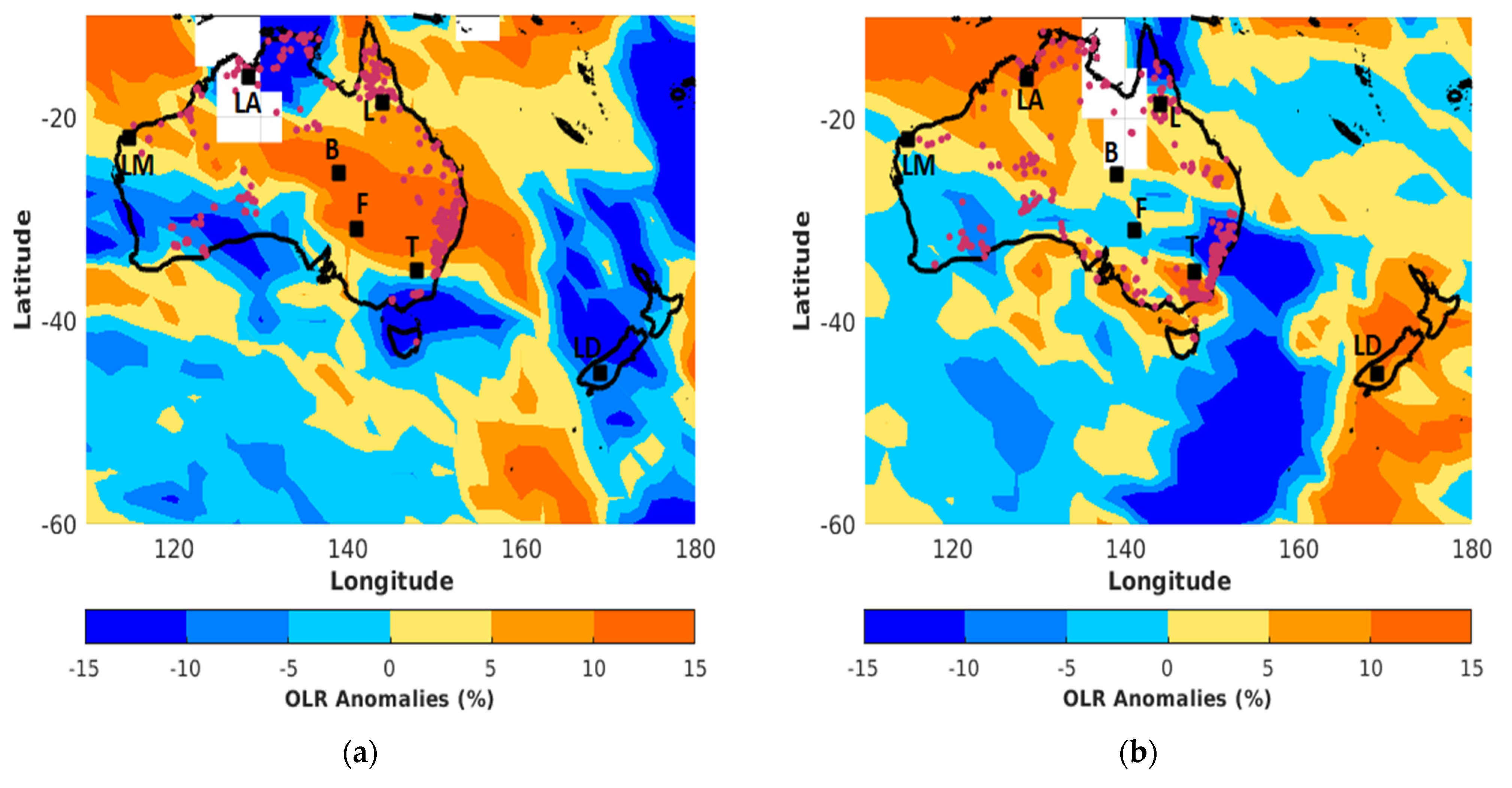
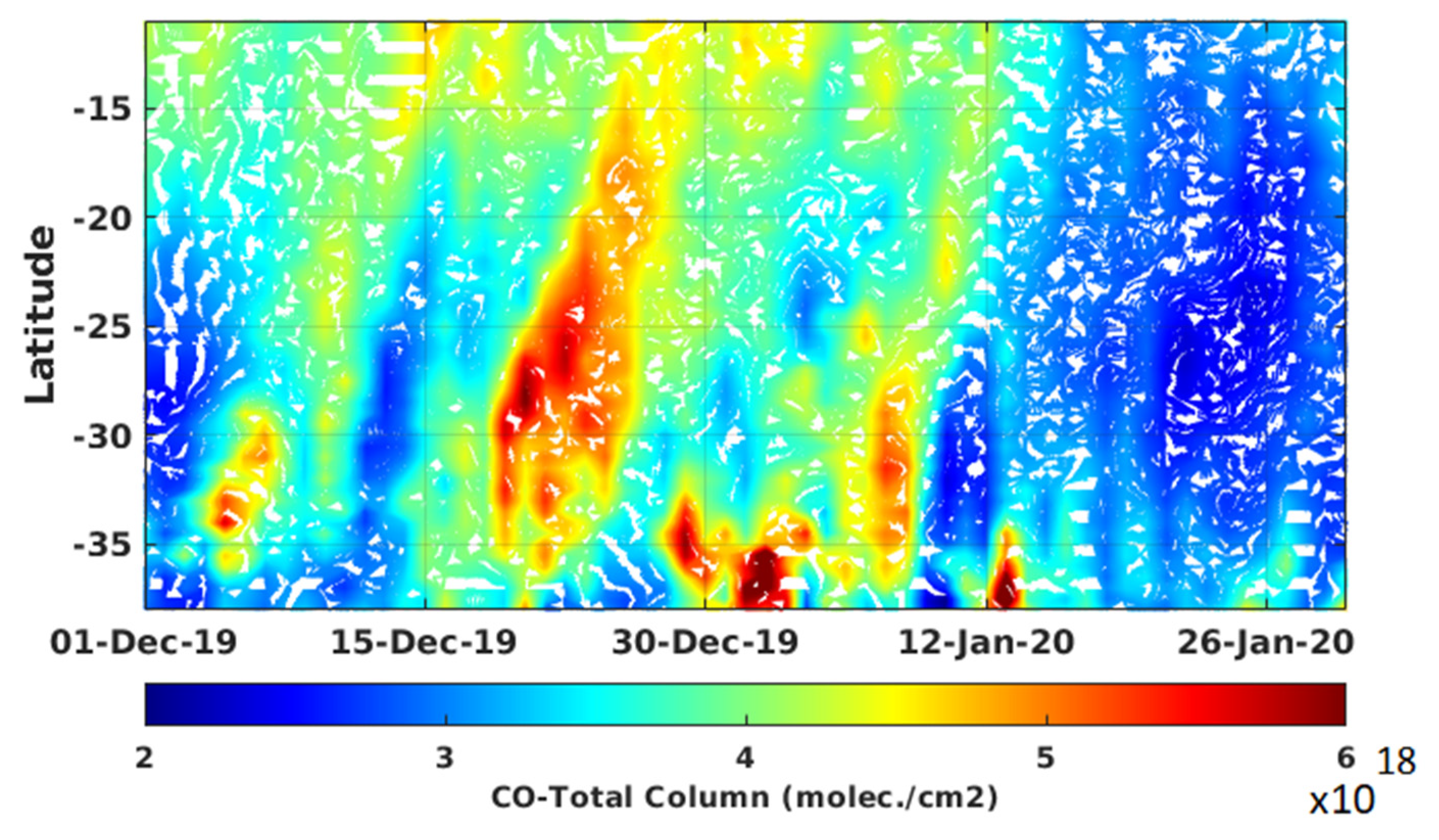
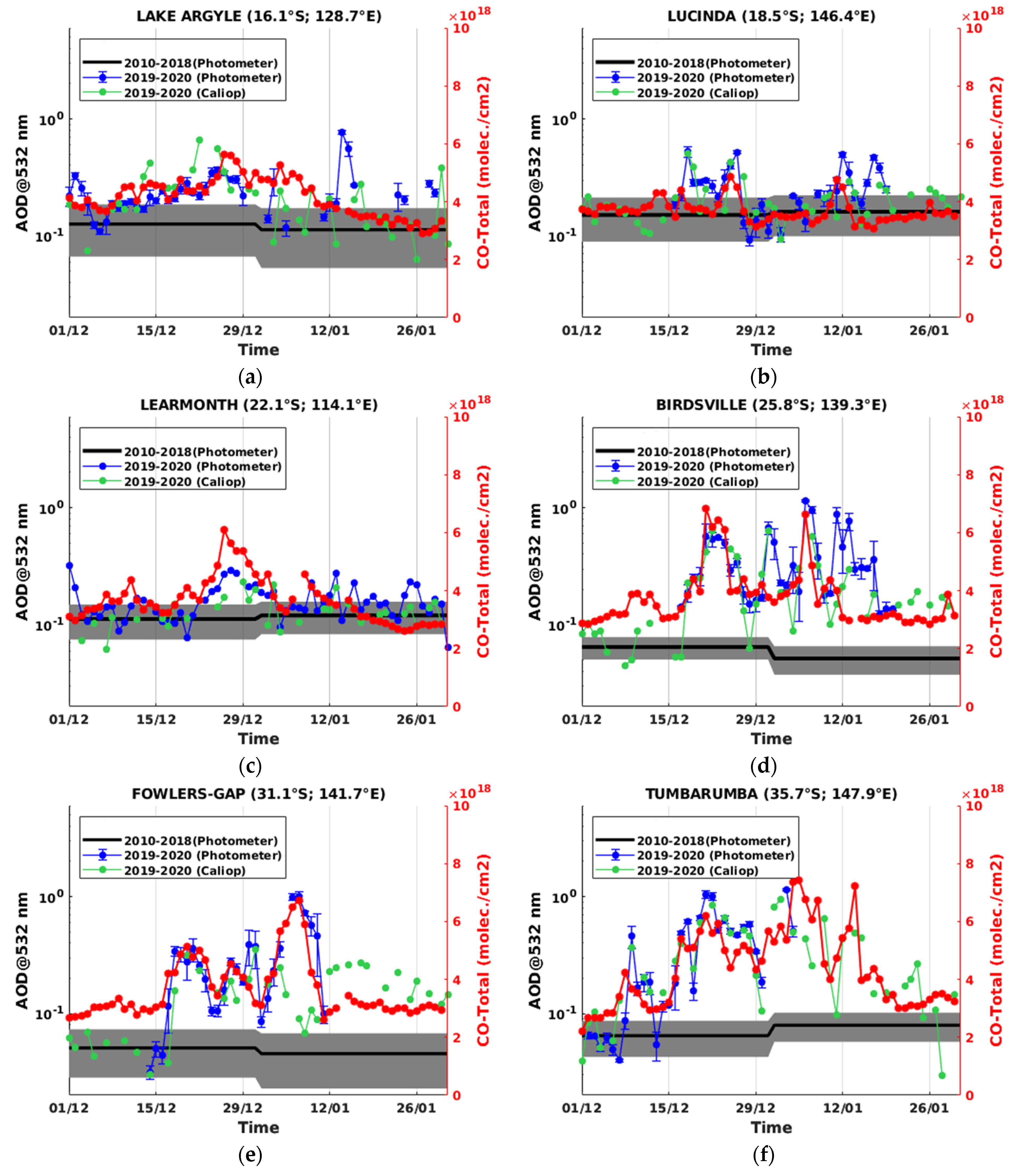
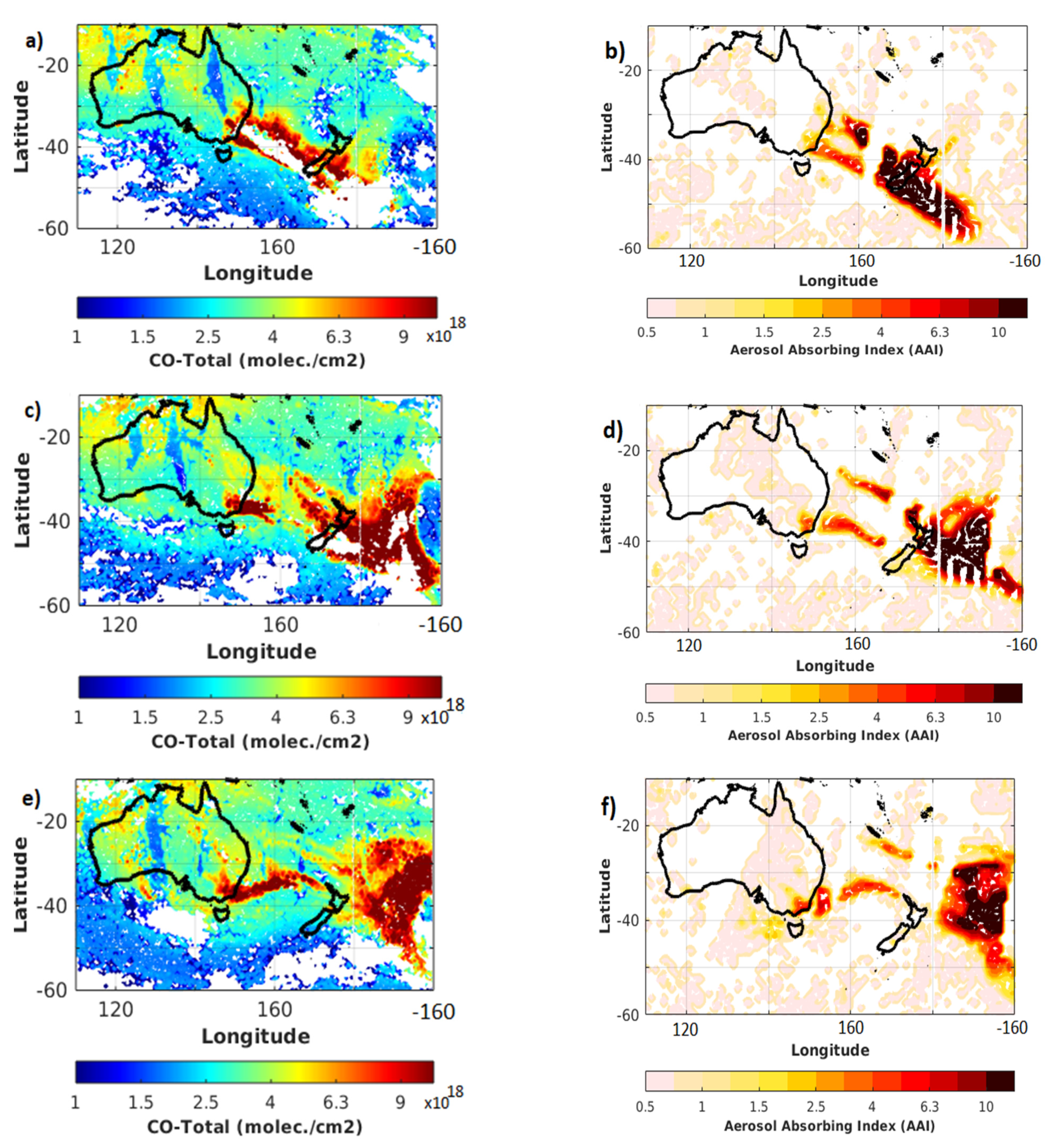
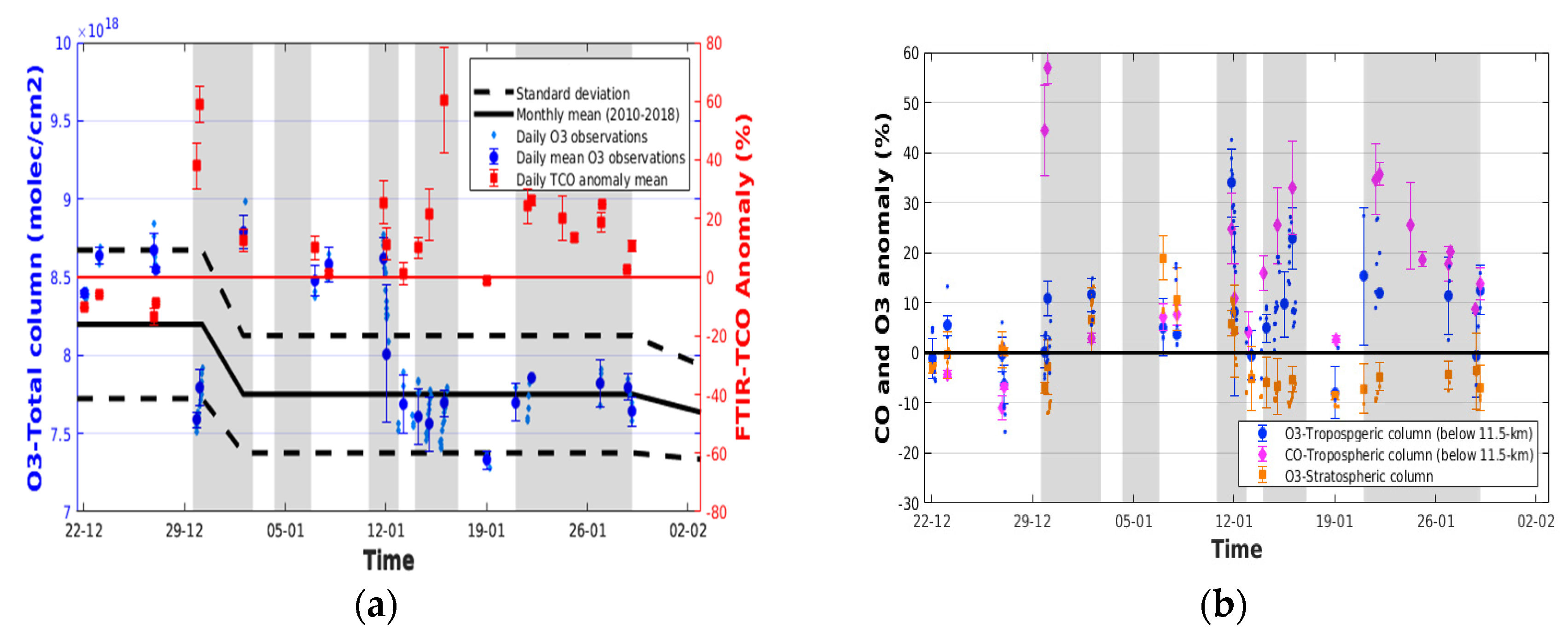
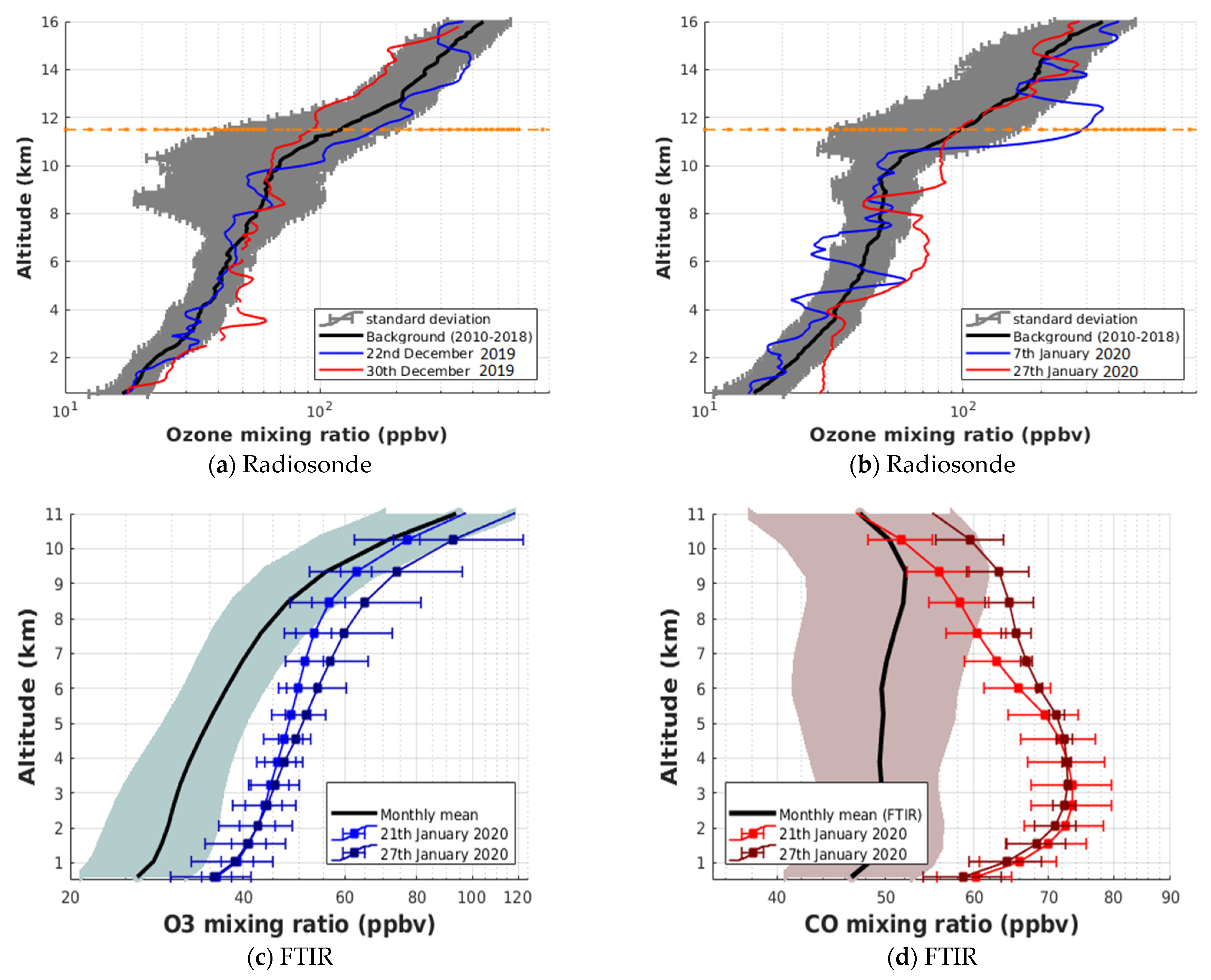
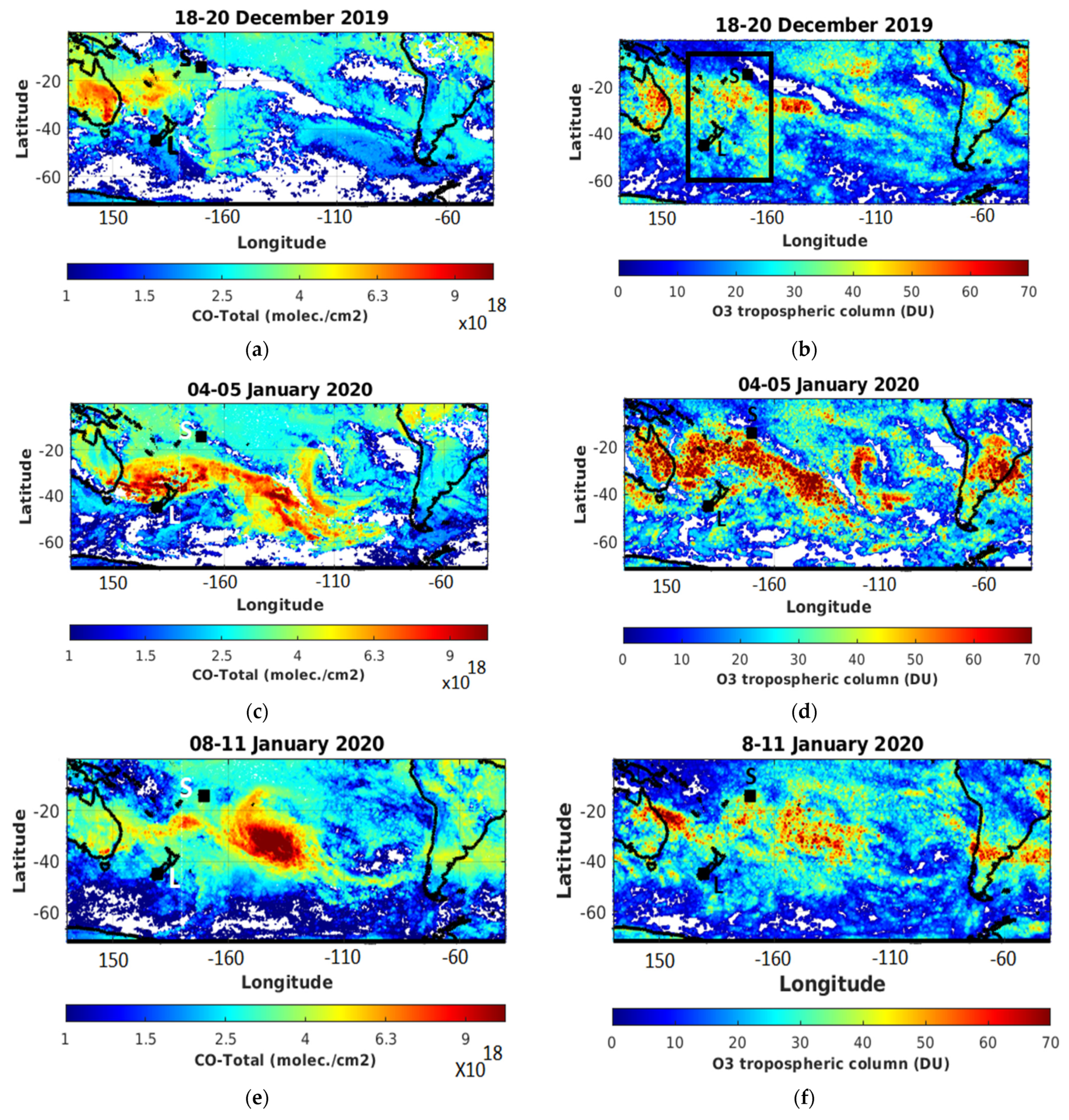

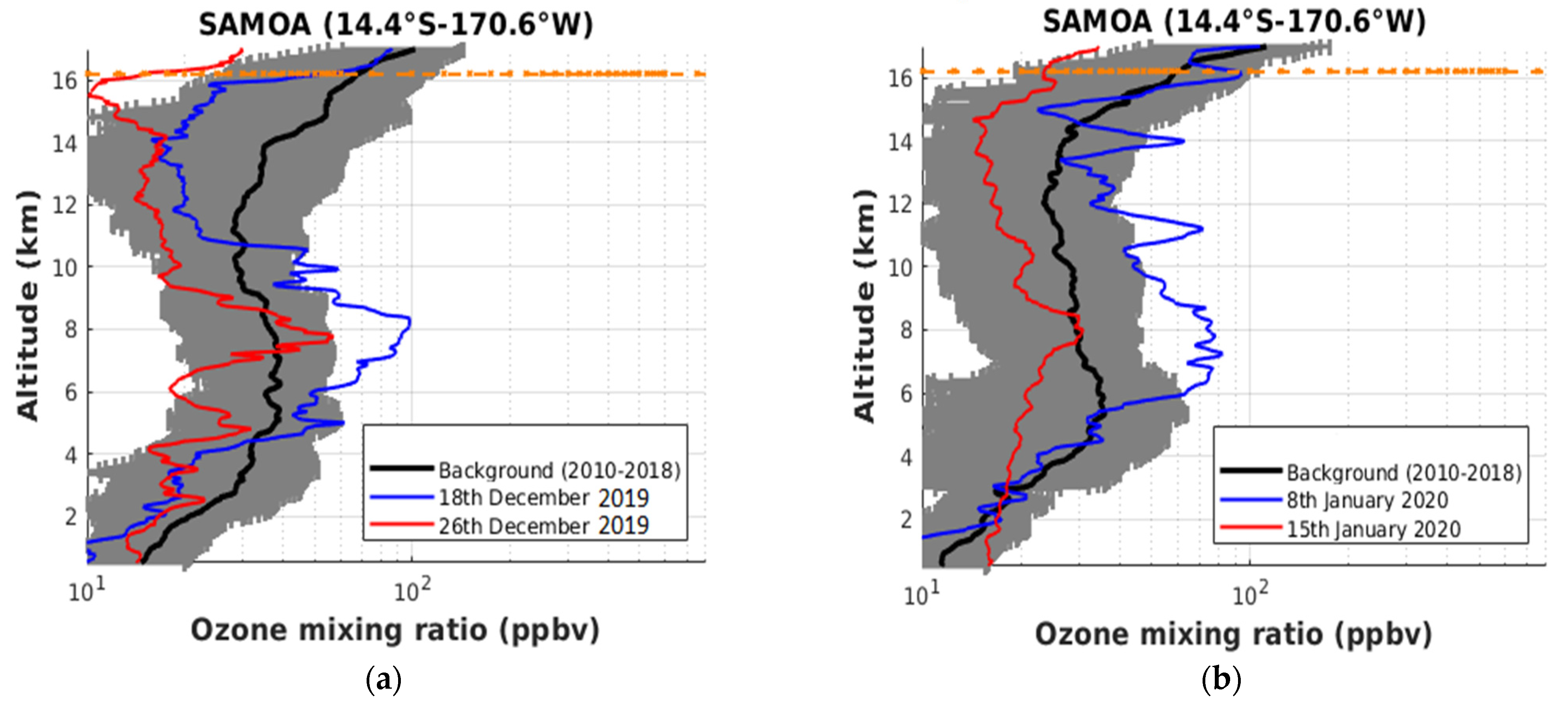
| Number | Period | Enriched Ozone Layer (km) | Mean ΔO3/ΔCO (ppbv/ppbv) | Plume Age Category |
|---|---|---|---|---|
| 1 | 30 December 2019–2 January 2020 | 2–5 | 0.13 ± 0.01 | ≤1–2 days |
| 2 | 4–6 January 2020 | |||
| 3 | 10–12 January 2020 | 3–8 | 0.14 ± 0.05 | ≤1–2 days |
| 4 | 15–18 January 2020 | 2–6 | 0.41 ± 0.25 | 2–5 days |
| 5 | 20–28 January 2020 | 2–8 | 0.35 ± 0.10 | 2–5 days |
Publisher’s Note: MDPI stays neutral with regard to jurisdictional claims in published maps and institutional affiliations. |
© 2021 by the authors. Licensee MDPI, Basel, Switzerland. This article is an open access article distributed under the terms and conditions of the Creative Commons Attribution (CC BY) license (https://creativecommons.org/licenses/by/4.0/).
Share and Cite
Bègue, N.; Bencherif, H.; Jégou, F.; Vérèmes, H.; Khaykin, S.; Krysztofiak, G.; Portafaix, T.; Duflot, V.; Baron, A.; Berthet, G.; et al. Transport and Variability of Tropospheric Ozone over Oceania and Southern Pacific during the 2019–20 Australian Bushfires. Remote Sens. 2021, 13, 3092. https://doi.org/10.3390/rs13163092
Bègue N, Bencherif H, Jégou F, Vérèmes H, Khaykin S, Krysztofiak G, Portafaix T, Duflot V, Baron A, Berthet G, et al. Transport and Variability of Tropospheric Ozone over Oceania and Southern Pacific during the 2019–20 Australian Bushfires. Remote Sensing. 2021; 13(16):3092. https://doi.org/10.3390/rs13163092
Chicago/Turabian StyleBègue, Nelson, Hassan Bencherif, Fabrice Jégou, Hélène Vérèmes, Sergey Khaykin, Gisèle Krysztofiak, Thierry Portafaix, Valentin Duflot, Alexandre Baron, Gwenaël Berthet, and et al. 2021. "Transport and Variability of Tropospheric Ozone over Oceania and Southern Pacific during the 2019–20 Australian Bushfires" Remote Sensing 13, no. 16: 3092. https://doi.org/10.3390/rs13163092
APA StyleBègue, N., Bencherif, H., Jégou, F., Vérèmes, H., Khaykin, S., Krysztofiak, G., Portafaix, T., Duflot, V., Baron, A., Berthet, G., Kloss, C., Payen, G., Keckhut, P., Coheur, P.-F., Clerbaux, C., Smale, D., Robinson, J., Querel, R., & Smale, P. (2021). Transport and Variability of Tropospheric Ozone over Oceania and Southern Pacific during the 2019–20 Australian Bushfires. Remote Sensing, 13(16), 3092. https://doi.org/10.3390/rs13163092







